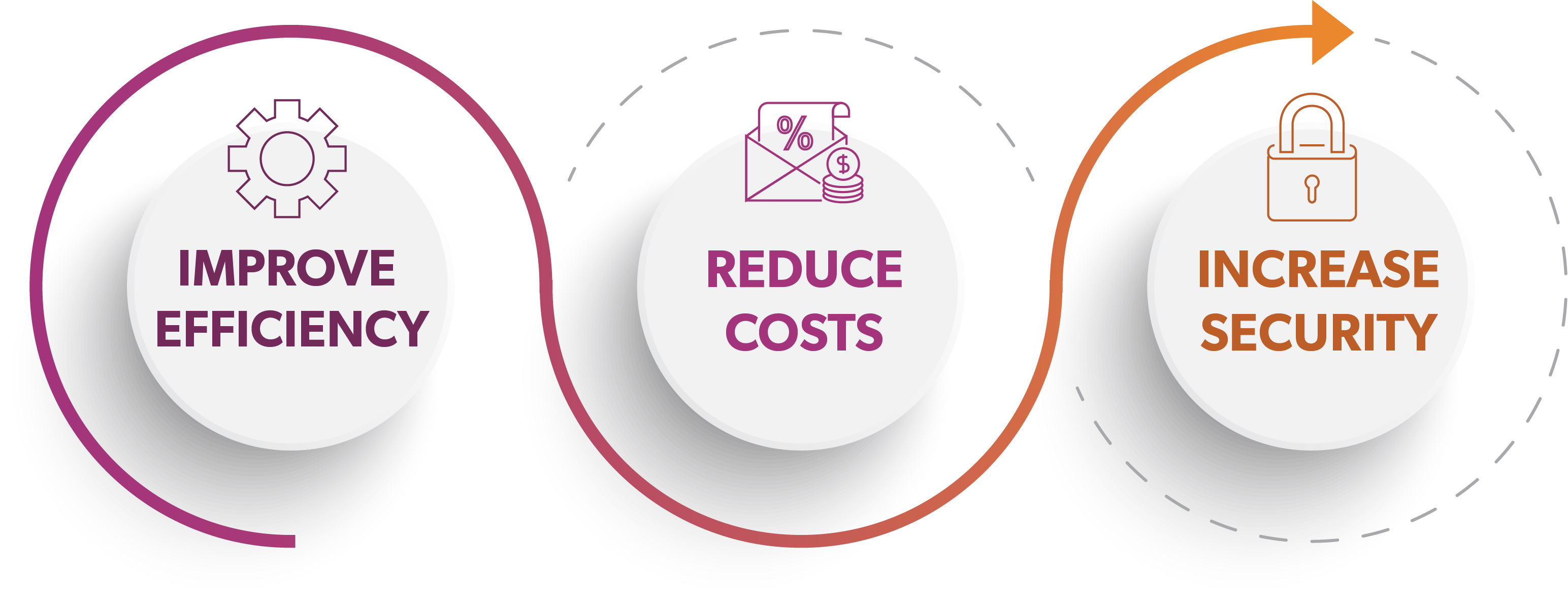Helping organizations and businesses improve the efficiency of the accounts payable process, while reducing costs, and increasing security is the ongoing mission behind just about everything we do in Treasury Management at First Business Bank. It has never been more important to make the payment process easier and faster for businesses. With the shift in how and where we work, coupled with a tight labor market, any business can benefit from Integrated Payables solutions that securely streamline the payment process.
What Are Integrated Payables?
Integrated Payables is a payment process solution that allows your business to outsource your accounts payable to First Business Bank by submitting one final AP file that accommodates multiple payment methods to pay your suppliers and vendors.
The latest Treasury Management addition, Integrated Payables, provides three core advantages for business clients. Our Integrated Payables solution technology helps companies:
- Improve efficiency by streamlining electronic payment processing
- Reduce costs associated with accounts payable
- Strengthen invoice processing payment security
The pandemic influenced more businesses to adopt or to consider electronic payments. In fact, B2B payment volume of Automated Clearing House (ACH) electronic payments increased by more than 10% in 2020 and 17% in 2021, according to the Association of Finance Professionals’ Digital Payments survey.
While the volume of commercial checks collected by the Federal Reserve has dwindled since a high in 1993 and fell to less than half of what it was 10 years ago, many cite the cost of making changes to internal processes as a “major barrier” to changing over to electronic payments. With our Integrated Payables solution, your payables can actually generate revenue while eliminating certain accounts payable transaction costs.
The Key Benefits You Get When You Integrate Your Payables

Improving Accounts Payable Process Efficiency
With Integrated Payables, your business consolidates ACH, wire, check, and virtual card vendor payments into a single file that you upload into your online banking platform with your payments processor — First Business Bank. The payment file can also be transmitted directly from your companies’ payables software to the bank, further reducing steps involved.
By outsourcing your payment process through Integrated Payables solutions like this, you streamline your internal accounts payable processes while we initiate payments for you. We print checks and mail them on your behalf with priority shipping options available as needed. This allows you to initiate a check payment from the convenience of your home office, business office, or anywhere you have a secure connection to Online Banking.
No-Hassle Integrated Payables Vendor Enrollment
As your Integrated Payables vendor, we also help behind the scenes by educating your vendors to convert paper check payments to electronic payments, such as ACH or virtual card. Our supplier enablement team reaches out to your vendors based on your preferences of payment methods.
Check Printing And Mailing Services Reduce Costs
As we convert your payments from check to Integrated Payables electronic payments, you reduce or eliminate check printing and mailing costs. For instance, the lowest processing cost of a paper check is estimated at $2.05 per check, although recently one of our clients estimated their per-check cost at $8 each! Processing 3,000 checks per month therefore results in an annual check processing cost of $73,000. This is the minimum!
Imagine if you could cut that in half – without increasing staff. ACH payments cost about 50 cents each to process. If you convert payment methods to 50% ACH, you lower your paper check cost from $73,000 annually to about $46,000 annually.
Virtual card payments are another popular payment method within Integrated Payables. Simply stated, a virtual card is a single-use credit card number issued electronically to a vendor for a precise amount with a 16-digit card number, expiration date, and CVV code. Virtual payments allow businesses to keep their banking information private from vendors and suppliers, and after the payment is processed, the card number is no longer valid. Virtual cards are secure and remain one of the most cost-effective payments to initiate with little to no transaction costs. In addition, your business can earn revenue with a cash rebate based on the dollar volume processed through virtual cards. When you hear about a company’s finance department earning revenue, this is how they’re accomplishing it — and now your business can, too.
Increase Security & Reduce Check Fraud
Last — but certainly not least — we saw an increase overall in fraud affecting businesses over the past year. The Association for Financial Professionals’ “2021 AFP Payments Fraud and Control Survey Report” shows that paper checks continue to rank as the top payment method affected by fraud — 66% of those surveyed reported check fraud activity, which is down from 74% a year earlier. The report attributes a decrease in check fraud to the increase of electronic payments!
Our team is passionate about what we do, and we fully believe that Integrated Payables may be the right payment process solution for many small- and medium-sized businesses that have delayed migrating to electronic payments until now. For more examples about how our clients are using this successfully to save money and streamline their operations, talk to your First Business Bank representative about the ROI for your unique situation at your business.





